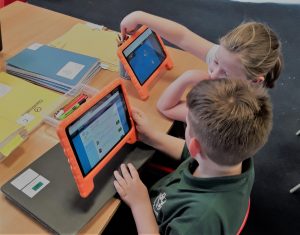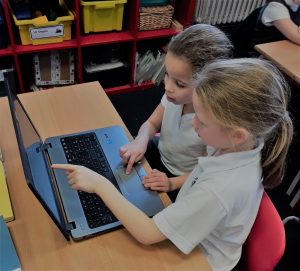At St Mary’s our Computing Curriculum maps have been created using the BPSI framework. This framework is made up of three key strands: Programming and Computer Science, Creative Use of IT and Digital Literacy.
Computing Purpose of Study:
A high-quality computing education equips pupils to use computational thinking and creativity to understand and change the world. Computing has deep links with mathematics, science, and design and technology, and provides insights into both natural and artificial systems. The core of computing is computer science, in which pupils are taught the principles of information and computation, how digital systems work, and how to put this knowledge to use through programming. Building on this knowledge and understanding, pupils are equipped to use information technology to create programs, systems and a range of content. Computing also ensures that pupils become digitally literate – able to use, and express themselves and develop their ideas through, information and communication technology – at a level suitable for the future workplace and as active participants in a digital world.
Aims:
The national curriculum for computing aims to ensure that all pupils:
▪ can understand and apply the fundamental principles and concepts of computer science, including abstraction, logic, algorithms and data representation
▪ can analyse problems in computational terms, and have repeated practical experience of writing computer programs in order to solve such problems
▪ can evaluate and apply information technology, including new or unfamiliar technologies, analytically to solve problems
▪ are responsible, competent, confident and creative users of information and communication technology.
Computing has close links to many other curriculum areas, so is often taught through a cross-curricular approach. Pupils are taught the principles of information and computation, how digital systems work and how to put this knowledge to use through programming. Building on this knowledge and understanding, the second strand ensures pupils are equipped to use information technology creatively; to create programs, systems and a range of content. Finally, but essentially, the computing curriculum teaches children to become digitally literate (as active participants in a digital world); ensuring they are responsible, competent, confident users of information and communication technology.


Our approach to computing is flexible, to ensure the most effective curriculum links and purposeful learning opportunities. Key skills are taught and consolidated through the year, with e-safety being a feature of every half term. The ideas of computing are applied to understanding real-world systems and creating purposeful products. This combination of principles, practice and invention makes computing an extraordinarily useful and intensely creative subject.
Purple Mash:
Purple Mash cloud-based platform for primary-aged children. We use this resources to provide a wide range of age-appropriate, creative software tools for writing, drawing, coding, animating, blogging and much more. In addition to these programs, the platform provides resources and themed lesson activities, which are also set for pupils to do at home.
For further information please click here: